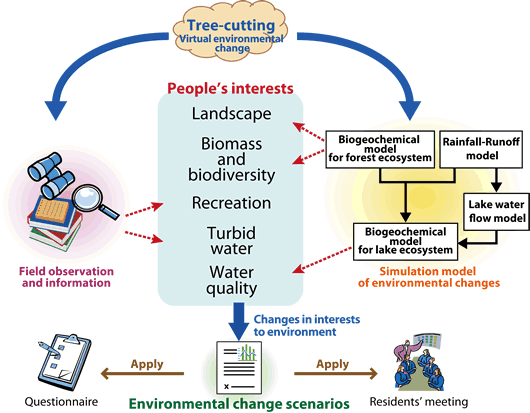Interaction between Environmental Quality of the Watershed and Environmental Consciousness: With Reference to Environmental Changes Caused by the Use of Land and Water Resource
This project examined the relationship between environmental perception, environmental attitudes and values -- or environmental consciousness -- and the quality of a forested watershed ecosystem. Theoretical analysis and empirical surveys were used to identify the environmental factors that affect formation of environmental consciousness. We then developed response-prediction models and used a choice experiment to identify people's preferences in several scenarios of environmental change.
Project Findings
This project examined the relationship between people's environmental consciousness and the environmental quality of a forested watershed ecosystem. Using responseprediction models, which can simulate environmental changes in a forest-river-lake ecosystem caused by artificial environmental modification, project researchers analyzed popular perception of environmental change around Lake Shumarinai, the largest reservoir in Japan, in Horokanai, Hokkaido. We conducted a choice-experiment with members of the Lake Shumarinai and other watershed communities in which people were asked to indicate their preferred of several model-generated virtual scenarios of environmental changes accompanying different forest management plans. Results of the “Scenario questionnaire” indicated that people preferred area tree-cutting that does not negatively affect water quality. The most common next concern was for “Decreases in plant biomass and diversity”. Surveys also suggested that people distinguished between the direct, indirect and non-use values of forested watershed environments.
Contribution to global environmental studies
Human beings enjoy the benefits of nature; their perception of these environmental benefits affects their attitudes toward and values concerning their surrounding environments. Environmental perception, attitudes and values together indicate environmental consciousness, an important, but often overlooked, dimension in the consideration of appropriate interactions between humanity and nature. How do people evaluate human-caused environmental change? Environmental values should be a key factor in environmental decision-making. The methods developed in this project can enhance public involvement in environmental impact assessment and city and regional planning.
Communication of research findings
A scenario workshop was held in Horokanai town, Hokkaido. Residents described their ideas and visions of future natural environments and social life. Social and natural scientists contributed to the workshop as interpreters and facilitators. As an outcome of the project, we conducted an open symposium in Horokanai in November, 2008 and published a book (in Japanese), entitled “A Method for Analyzing Environmental Consciousness with Environmental Scenarios”. A number of original papers for academic audiences have also been published.
 |
Analysis of environmental consciousness |

